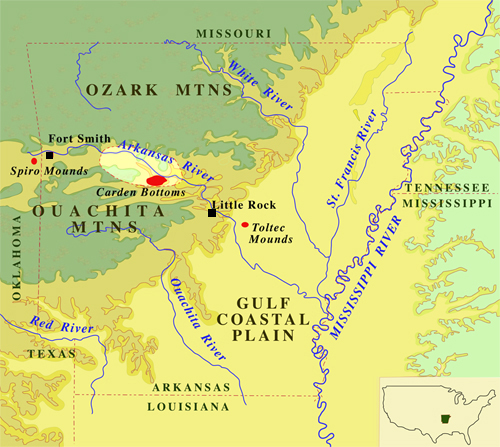|
Introduction
The Carden Bottoms locality of the central Arkansas River Valley is well known for extraordinary artifact collections, including hundreds of exquisitely decorated ceramic vessels, preserved in museums across the country. These materials represent late prehistoric to protohistoric era (A.D. 1400 – 1700) Carden Bottoms phase communities. Design elements on these artifacts reflect artistic styles originating at the world-famous Cahokia site near modern St. Louis and later represented in ceremonial contexts at the Spiro Mounds site located in the Arkansas River Valley. Carden Bottoms phase ceramics also reflect pottery-making traditions associated, respectively, with the central Mississippi Valley to the east and the Ouachita Mountain/Gulf Coastal Plain region to the south. Yet we know almost nothing about the people who produced these extraordinary materials. Attempts to reconstruct their lives are complicated by the fact that the existing collections are mostly from cemeteries looted during the early 20th century (Harrington 1924). Prospects for modern investigations at remaining sites are threatened by destruction from continued looting and other modern land use practices. This worrisome circumstance alarms archeologists and modern American Indians alike. In response this circumstance, the Caddo, Osage, and Quapaw descendants of the pre-contact people who lived in this part of Arkansas will join Arkansas Archeological Survey archeologists to conduct new research on the occupational history of Carden Bottoms phase sites. This project will employ modern remote sensing technologies to locate preserved cultural features at known archeological sites. Excavation of selected non-mortuary features will furnish new information on the structure and content of Carden Bottom phase sites, and better contextual information for studying the existing museum collections. Synthetic analysis of the combined data sets will examine the role of art and ritual in the expression of community identities and the organization of regional social interaction. |
